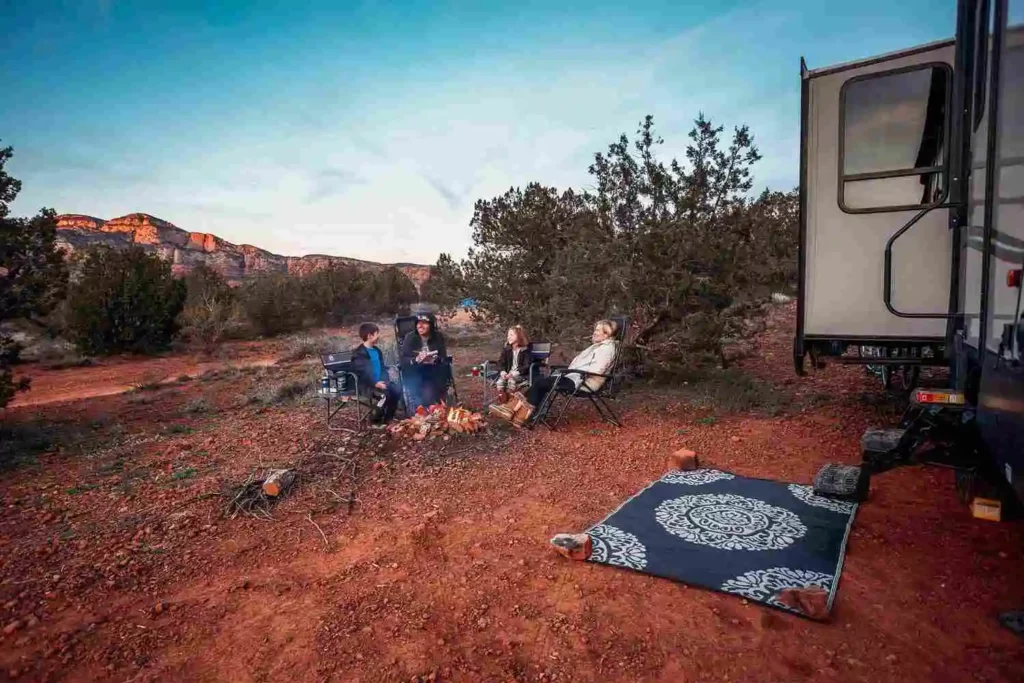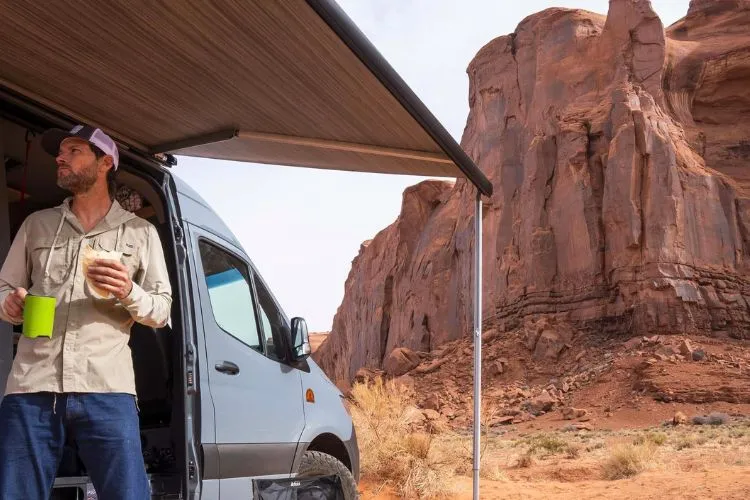Boondocking, also known as dispersed camping, is the quintessence of connecting with nature by camping without the hookups and amenities that come with traditional campgrounds.
This article delves into what boondocking truly is, its appeal to modern campers, and how you can embark on your own off-grid adventures while traversing the thin line between legal bounds and the wild unknown.

What Is Boondocking? Let’s Simplify
At its core, boondocking represents the art of self-sufficient camping, often in solitude and remote areas. While RVers most commonly use the term, it encompasses a broad spectrum of camping outside designated campgrounds without access to external power, water, or sewer connections.
Originating from the American West, ‘boondocking’ draws its etymological roots from “boondocks,” a term referring to rough and isolated terrains. This historical backdrop paints a picture of boondocking as a return to wilderness, adhering to a minimalist and self-reliant way of exploring.
Different Interpretations
Boondocking doesn’t bear the same meaning for every RVer or camper. Some view it as camping completely off-grid in remote wilderness areas, while others may consider overnight parking in urban settings outside of established campsites as a form of boondocking.
Essentially, it revolves around the idea of free camping—finding a spot, setting up your camp, and relying solely on what you’ve brought with you, from water supplies to solar panels for electricity.
Why Boondock?
The allure of boondocking is multifaceted. One of the paramount advantages is cost. By avoiding fees associated with traditional campsites, travelers can significantly reduce their trip expenses.
Moreover, boondocking offers an unparalleled level of freedom and flexibility, allowing campers to break free from the crowd and the noise, setting up their home wherever they find peace.
This unmediated interaction with nature fosters a deep connection to the environment, presenting an unparalleled way to enjoy the serenity and beauty of the natural world.

Drawbacks of Boondocking
However, boondocking does not come without its challenges. The absence of utilities such as water, electricity, and sewage disposal means campers must be well-prepared and conservative with their resources.
Additionally, the solitude and remote locations, while appealing to many, can pose safety concerns, from wildlife encounters to emergencies far from help.
How to Boondock?
Successful boondocking starts with meticulous preparation. Essential equipment includes water storage and filtration systems, reliable power sources (such as solar panels or generators), and sufficient waste disposal options.
Mapping out potential locations ahead of time is crucial, as is understanding the limitations of your vehicle and the terrain you plan to explore. Research, planning, and a dash of adventure spirit are your best tools.

Practical Tips for Successful Boondocking
Conservation is key while boondocking. Wise management of water, power, and other resources ensures a longer, more comfortable stay in the wilderness.
Safety measures, such as informing someone about your whereabouts and expected return, carrying a comprehensive first aid kit, and understanding basic survival skills, are fundamental. Boondockers must always tread lightly, practicing Leave No Trace principles to preserve the natural beauty for future travelers.
Legal Aspects of Boondocking
Boondocking freely in the great outdoors is a dream many share, but it’s crucial to navigate the legal landscape that governs such activities. The legality of boondocking varies significantly across the country and the world.

In the U.S., many federal lands managed by the Bureau of Land Management (BLM) and National Forests allow dispersed camping, but with varying restrictions and guidelines. Prior research into the specific regulations of your chosen area, including stay limits and required permits, is indispensable to ensure a trouble-free experience.
Frequently Asked Questions (fAQs)
Is Boondocking safe?
Boondocking can be as safe as any other form of camping, provided you take necessary precautions, remain aware of your surroundings, and prepare for emergencies. Choosing safe, legal locations to set up camp is crucial.
Is Boondocking legal everywhere?
No, boondocking is not legal everywhere. It is generally permitted on most Bureau of Land Management lands and in National Forests in the United States, but there are exceptions and specific rules. Always check local regulations before deciding on a boondocking location.
What equipment do I need to boondock?
At a minimum, you’ll need a water filtration and storage system, a source of power (solar panels or generators), and a way to manage waste. Also, consider navigation tools, a first aid kit, and sufficient food and utilities to last the duration of your stay.
Can I boondock in an urban area?
Urban boondocking, often referred to as stealth camping, involves overnight parking in urban settings but comes with a different set of legal and safety considerations. Always ensure it’s legal and safe to park overnight in your chosen location.
How long can you typically boondock in one place?
The allowed duration varies by location, but on BLM land and in National Forests, the stay limit is often 14 days within any 28-day period. After this period, you must relocate at least 25 miles from your original campsite.
Conclusion
Boondocking embodies the essence of adventure—merging self-sufficiency, respect for nature, and the quest for serenity away from the crowded modern world. It opens up a realm of possibilities for those willing to embrace its challenges, promising unforgettable experiences amidst the untouched corners of the planet.
As we seek to explore and connect with the environment on our terms, boondocking stands out as a profound way to journey through life’s many landscapes. Prepare well, respect the natural world, and embrace the freedom that comes with making the wilderness your home, even if only for a night.


